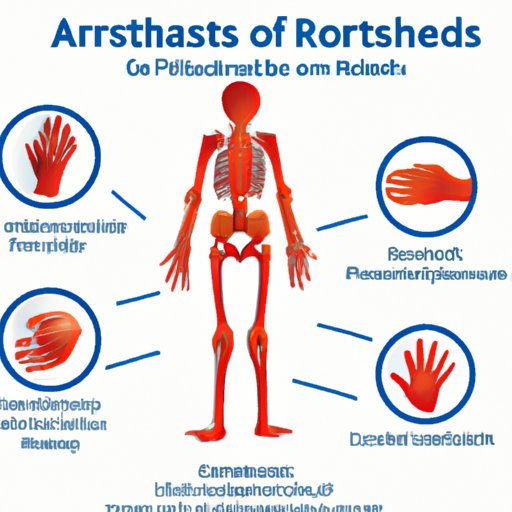
Introduction
Psoriatic arthritis is a condition that affects millions of people worldwide. It is a type of arthritis that commonly affects people who have psoriasis, a chronic skin condition that causes red, scaly patches on the skin. Although psoriatic arthritis is not as well-known as other types of arthritis, it is important to recognize its symptoms and seek medical attention when necessary. In this article, we will provide a comprehensive guide to understanding psoriatic arthritis symptoms and offer some coping strategies for managing them.

Understanding Psoriatic Arthritis Symptoms: A Comprehensive Guide
Psoriatic arthritis is a chronic inflammatory condition that affects the joints, causing pain, swelling, and stiffness. It can also affect other parts of the body, such as the skin, eyes, or tendons. The condition can develop slowly or suddenly and can affect anyone, regardless of age or gender. Although the underlying cause of psoriatic arthritis is not yet fully understood, evidence suggests that genetics, environmental factors, and the immune system play a role in its development.
The symptoms of psoriatic arthritis can vary widely between individuals, but the most common symptoms include joint pain, swelling, and stiffness. In some cases, the inflammation can cause the joints to become deformed or damaged over time. In addition, people with psoriatic arthritis may also experience fatigue, nail changes, eye inflammation, and a reduced range of motion in the affected joints.
One of the key features of psoriatic arthritis is its link to psoriasis, a skin condition that affects around 2-3% of the population. In fact, up to 30% of people with psoriasis will develop psoriatic arthritis at some point in their lives. Psoriasis usually appears before the arthritis, but in some cases, joint problems can occur before skin symptoms appear.
Spotting the Signs: Psoriatic Arthritis Symptoms You Should Know
One of the challenges of psoriatic arthritis is that its symptoms can be similar to other types of arthritis or medical conditions, such as rheumatoid arthritis or osteoarthritis. That’s why it’s important to recognize the signs of psoriatic arthritis and seek medical attention if you experience any of them.
The most common symptoms of psoriatic arthritis include:
- Joint pain and swelling
- Tenderness and stiffness in the joints, especially in the morning or after sitting for a long time
- Reduced range of motion in the affected joints
- Fatigue and overall feeling of sickness
- Pain in the tendons or ligaments, especially in the back of the heel or bottom of the foot
- Nail changes, such as pitting or separation from the nail bed
If you experience any of these symptoms, it’s essential to seek medical attention promptly. Early diagnosis and treatment can help manage the symptoms and prevent further joint damage.
Not Just Skin Deep: The Lesser-Known Symptoms of Psoriatic Arthritis
Aside from the common symptoms, psoriatic arthritis can also cause some less well-known symptoms that can significantly impact daily life. These symptoms can include:
- Eye inflammation (uveitis) – symptoms include eye pain, redness, and sensitivity to light; it’s essential to seek medical attention if you have any eye symptoms as uveitis can lead to permanent vision loss if left untreated
- Inflammatory bowel disease (IBD) – people with psoriatic arthritis are at an increased risk of developing IBD, which can cause abdominal pain, diarrhea, and weight loss
- Cardiovascular disease – psoriatic arthritis can increase the risk of developing cardiovascular disease, such as heart attacks and strokes, so managing risk factors such as high blood pressure and high cholesterol is crucial
- Depression and anxiety – chronic pain and other symptoms of psoriatic arthritis can take a toll on mental health, so seeking emotional support from friends, family, or a therapist can be helpful
It’s important to be aware of these symptoms and seek medical guidance if they occur as early intervention can help prevent further complications.
The Warning Signs of Psoriatic Arthritis: What to Look Out For
Psoriatic arthritis can have serious consequences if left untreated, so it’s essential to recognize the warning signs and take action when needed.
Some signs that you may need medical attention include:
- Severe joint pain that persists for several days
- Joint swelling that’s accompanied by fever
- Skin rashes that appear suddenly or become more severe
- Joint stiffness that lasts longer than 30 minutes in the morning
- Joint pain or stiffness that interferes with daily activities
It’s also important to be aware of common misdiagnoses, such as fibromyalgia, gout, or osteoarthritis, that can delay the proper diagnosis. That’s why it’s crucial to be vigilant and seek a second opinion if you’re not satisfied with your diagnosis or treatment plan.
When Your Joints Speak: Psoriatic Arthritis Symptoms to Watch Out For
Joint pain is one of the hallmark symptoms of psoriatic arthritis, and it can affect any joint in the body, including the fingers, toes, ankles, knees, and spine. In some cases, it can cause permanent joint damage, so managing and preventing joint pain is crucial.
Some strategies for managing joint pain include:
- Regular exercise – low-impact exercises, such as swimming or cycling, can help improve joint flexibility and reduce pain
- Heat and cold therapies – alternating between hot and cold packs can help reduce inflammation and soothe sore muscles
- Rest and relaxation – taking breaks and avoiding overexertion can help reduce joint stress and pain
- Medications – over-the-counter pain relievers, such as acetaminophen or ibuprofen, can help manage mild to moderate joint pain, while prescription medications and biologic agents can help manage more severe symptoms
- Rehabilitation – working with a physical therapist or occupational therapist can help improve strength and flexibility in the affected joints
It’s important to listen to your body and not push yourself too hard, especially during flare-ups when symptoms are more severe.
Connecting the Dots: How Psoriasis and Joint Pain May Signal Psoriatic Arthritis
Psoriasis and joint pain are two hallmark symptoms of psoriatic arthritis, and recognizing the link between them is crucial for early diagnosis and treatment.
Up to 30% of people with psoriasis will develop psoriatic arthritis, and in some cases, the arthritis symptoms can appear before the skin symptoms. That’s why it’s important to be vigilant and seek medical attention if you experience any joint pain or swelling, especially if you have psoriasis or a family history of the condition.
Coping strategies for dealing with the emotional toll of receiving a psoriatic arthritis diagnosis can include joining support groups, seeking therapy, or finding creative outlets for self-expression. It’s also important to remember that psoriatic arthritis is a manageable condition with the right treatment and lifestyle changes.
Living with Psoriatic Arthritis: Recognizing the Different Symptoms and Coping Strategies
Living with psoriatic arthritis can be challenging, but with the right treatment and coping strategies, it is possible to live a fulfilling life.
Some coping strategies for managing psoriatic arthritis symptoms include:
- Eating a healthy and balanced diet
- Getting regular exercise and physical activity
- Prioritizing rest and relaxation
- Seeking emotional support from loved ones or a therapist
- Finding creative activities that bring joy and fulfillment
It’s important to find a treatment plan tailored to your individual needs, which may include medications, physical therapy, or other interventions. It’s also essential to stay informed about the latest research and developments in psoriatic arthritis treatment options.
Conclusion
Psoriatic arthritis is a condition that affects millions of people worldwide, and it’s essential to recognize its symptoms and seek medical attention when necessary. By understanding the common and lesser-known symptoms of psoriatic arthritis, connecting the dots between psoriasis and joint pain, and finding the right coping strategies, it is possible to manage the condition and live a fulfilling life. Remember to seek medical attention if you experience any psoriatic arthritis symptoms and stay informed about the latest developments in treatment options.




